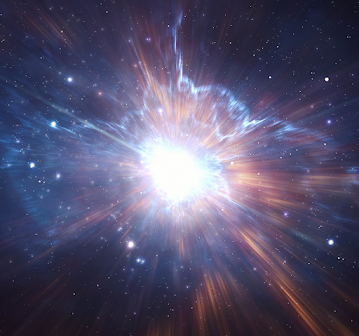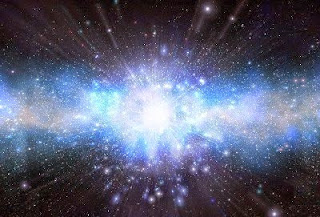Imagine the entire universe compressed into an infinitely small point, hotter and denser than anything we can conceive. Then, in a fraction of a second, everything expands, giving rise to space, time, matter, and energy. This is the Big Bang, the event that marked the birth of our universe about 13.8 billion years ago. But what exactly is the Big Bang? How do we know it happened? And how did it shape the cosmos we observe today? At The Astronomy Insider, we’ll explore these questions, unraveling the science behind the beginning of everything and how you can connect with the echoes of this event in the night sky.
What is the Big Bang?
The Big Bang wasn’t an explosion in the classical sense, like a bomb going off. Instead, it was an extremely rapid expansion of a singular point where all matter, energy, space, and time were concentrated. This point, smaller than an atom, had infinite density and temperature. About 10⁻³⁶ seconds after the beginning, the universe started expanding, cooling as it grew.
Think of it like inflating a balloon: as the balloon expands, the points on its surface move away from each other, but there’s no “center” to the explosion. In the Big Bang, the entire universe began expanding this way, and it continues to expand today. This idea was proposed in the 1920s by astronomer Georges Lemaître, who suggested that the universe had a beginning in a “primordial atom.”
Evidence for the Big Bang: How Do We Know It Happened?
The Big Bang theory is supported by robust evidence gathered over decades by astronomers and physicists. Here are the key pieces:
- Expansion of the UniverseIn 1929, Edwin Hubble discovered that distant galaxies are moving away from us, and the farther they are, the faster they move. This is measured by the redshift, a phenomenon where the light from galaxies “stretches” to longer, redder wavelengths, indicating that the space between us and them is expanding. If the universe is expanding today, in the past it was smaller, denser, and hotter, pointing to a single origin.
- Cosmic Microwave Background (CMB)In 1965, Arno Penzias and Robert Wilson detected faint, uniform radiation coming from all directions in the sky: the cosmic microwave background (CMB). This is the “leftover light” from the Big Bang, emitted when the universe was just 380,000 years old and cooled enough for atoms to form. The CMB, with a temperature of 2.7 Kelvin (-270.45°C), is like a snapshot of the young universe and confirms the predictions of the Big Bang theory.
- Abundance of Light ElementsIn the first few minutes after the Big Bang, the universe was a hot soup of particles where the first elements formed: hydrogen, helium, and traces of lithium. The theory predicts that about 75% of the universe’s matter would be hydrogen and 25% helium, proportions we observe in ancient stars and gas clouds. This primordial nucleosynthesis is direct evidence of the extreme conditions in the early cosmos.
- Structure of the UniverseThe Big Bang also explains how galaxies, clusters, and superclusters formed. Tiny density fluctuations in the early universe, detected in the CMB by telescopes like Planck, acted as gravitational “seeds.” Over time, these denser regions collapsed, forming the cosmic structures we see today.
Curious about how galaxies formed after the Big Bang? Check out our article “James Webb in 2025: Cosmic Revelations Redefining the Universe” to learn more about recent discoveries!
Timeline of the Big Bang
The Big Bang wasn’t a single event but the start of a series of stages that shaped the universe. Here’s a simplified timeline:
- 0 seconds: The Big Bang occurs. The universe is an infinitely dense and hot singular point.
- 10⁻³⁶ to 10⁻³² seconds: Inflation Era. The universe expands exponentially, smoothing out irregularities and defining its flat geometry.
- 10⁻⁶ seconds: Quark Era. The universe is a soup of fundamental particles, like quarks and gluons, at trillions of degrees.
- 3 minutes: Nucleosynthesis. Protons and neutrons combine, forming hydrogen and helium.
- 380,000 years: Recombination. The universe cools, electrons bind to nuclei, forming atoms. Light is released, creating the CMB.
- 100-200 million years: Era of the First Stars. The first stars and galaxies form, beginning reionization.
- 13.8 billion years (today): The universe is vast, filled with galaxies, stars, planets, and us, observing the cosmos.
How the Big Bang Shaped the Universe
The Big Bang didn’t just create the universe; it defined its fundamental characteristics:
- Space and Time: Before the Big Bang, there was no space or time. Both emerged with the expansion, and the universe continues to grow, as shown by observations from the Hubble Space Telescope and the James Webb Space Telescope.
- Matter and Energy: All matter (atoms, stars, planets) and energy (light, radiation) in the universe came from the Big Bang. Today, we know the universe is composed of ~5% ordinary matter, ~27% dark matter, and ~68% dark energy, which accelerates the expansion.
- Cosmic Structures: The initial fluctuations from the Big Bang led to the formation of galaxies, clusters, and cosmic filaments, creating the “cosmic web” that connects the universe.
- Conditions for Life: The Big Bang produced the light elements that, within stars, formed heavier elements like carbon and oxygen, essential for life. Without the Big Bang, we wouldn’t be here.
Want to know how stars created the elements for life? Check out our guide “How Stars Are Born and Die” at The Astronomy Insider!
Unanswered Questions
Despite its success, the Big Bang theory leaves open questions:
- What caused the Big Bang? We don’t know what existed “before” or what triggered the expansion.
- What is dark energy? It accelerates the expansion, but its nature remains a mystery.
- Was there anything before the Big Bang? Some physicists propose a “multiverse” or cycles of expansion and contraction, but these ideas are speculative.
Missions like the James Webb Space Telescope, which in 2025 is studying primordial galaxies, and the upcoming Nancy Grace Roman Space Telescope (set for 2027) are helping to answer these questions, bringing us closer to the beginning of the cosmos.
Connect with the Echoes of the Big Bang
The Big Bang may seem distant, but its effects are all around us. You can connect with the universe in practical ways:
- Observe the Night Sky: Use apps like Sky Tonight to find visible galaxies, like Andromeda, which formed billions of years after the Big Bang. In May 2025, Jupiter will be bright, perfect for observing with binoculars.
- Lunar Eclipse of 2025: The total lunar eclipse on March 13-14, visible in Brazil, is a chance to reflect on the expanding universe. Check out “How to Observe Eclipses Safely” to prepare!
- Get a Telescope: Want to explore the cosmos up close? See “The Best Telescopes for Amateur Astronomers” to choose the right equipment.
- Follow Astronomical Events: The National Observatory offers live streams, like the Venus-Jupiter conjunction on August 12, 2025.
Interested in distant worlds formed after the Big Bang? Read “Exoplanets: What They Are and How We Find Them” to learn more!
Sources
- NASA Science. “The Big Bang.” Accessed May 15, 2025. https://science.nasa.gov/universe/the-big-bang/
- ESA. “Planck and the Cosmic Microwave Background.” 2023. https://www.esa.int/Science_Exploration/Space_Science/Planck
- Weinberg, Steven. The First Three Minutes. Basic Books, 1993.
- The Astrophysical Journal. “Constraints on Big Bang Nucleosynthesis.” 2024.






No comments:
Post a Comment